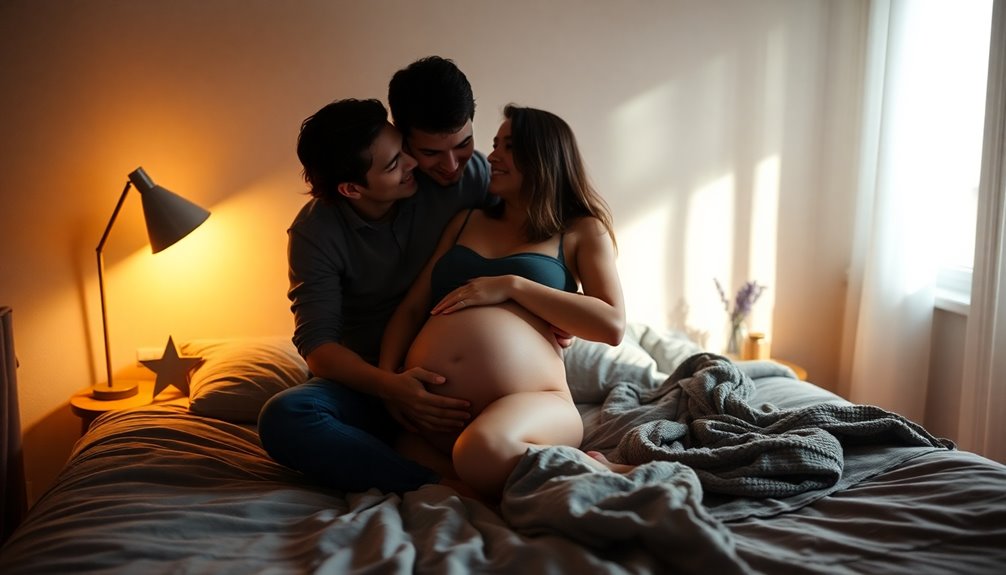Sex can potentially influence labor onset, but it isn't a foolproof method. When you engage in sexual activity, your body releases oxytocin and prostaglandins that might help initiate contractions. However, research shows mixed results, and the effectiveness can vary greatly from person to person. Your body's readiness for labor plays a significant role in whether sex will help. It's generally safe during a low-risk pregnancy, but open communication and consultation with your healthcare provider are important. If you're curious about more reliable methods and insights regarding labor induction, there's plenty more to explore.
Key Takeaways
- Sexual activity may release hormones like oxytocin, potentially leading to uterine contractions, but its effectiveness in inducing labor is inconsistent.
- While some studies suggest a link between sex and earlier deliveries, the evidence is mixed and not definitive.
- Generally safe for low-risk pregnancies, sex should be approached with caution if complications like placenta previa are present.
- The body's readiness for labor is crucial, making sex an unreliable method for induction; relaxation and acceptance of natural onset are encouraged.
- Consultation with healthcare professionals is essential for personalized advice regarding sex and labor induction during pregnancy.
Understanding Labor Induction

When it comes to understanding labor induction, it's essential to recognize that various methods can influence the onset of labor, though not all are effective or safe.
Sexual intercourse during pregnancy may play a role due to the release of oxytocin and the presence of prostaglandins in semen, but relying solely on sex to induce labor isn't reliable. Research shows mixed results; some studies indicate sexually active women might deliver earlier, while others find no significant link.
It's generally safe to have sex in late pregnancy unless complications like placenta previa exist.
The Role of Sex in Labor

When considering the role of sex in labor, it's important to understand the physiological mechanisms at play.
Research shows mixed findings on whether sexual activity can actually influence labor onset, so you might wonder how effective it really is.
Additionally, ensuring safety during intercourse in late pregnancy is vital, especially if there are any complications.
Physiological Mechanisms Explained
Although the connection between sex and labor might seem surprising, several physiological mechanisms suggest that sexual activity can play a role in initiating the labor process.
During orgasm, your body releases oxytocin, which can lead to uterine contractions similar to those caused by medical interventions like Pitocin. Additionally, semen contains prostaglandins, which may aid in cervical ripening and softening, helping prepare your body for labor.
The physiological response to orgasm can also trigger Braxton-Hicks contractions, signaling your body's readiness for the main event.
While these factors indicate that sex might augment natural labor processes, it's crucial to recognize that it's not a guaranteed method for inducing labor, as multiple hormonal and physiological factors are involved in the process.
Research Findings Overview
Research findings on the role of sex in labor reveal a complex relationship, with studies producing varying outcomes. Some research suggests that sexually active women may deliver sooner than those who are inactive.
For instance, a 2006 study indicated a connection between sexual activity and earlier deliveries, while a 2012 study found no significant correlation. Semen contains prostaglandins that can aid cervical ripening, and orgasm may release oxytocin, promoting contractions.
However, multiple hormones are needed for labor, so sex alone can't guarantee labor onset. A 2014 study linked sexual activity with lower gestational ages at delivery, but other findings suggest the body's readiness for labor plays a vital role.
Safety Considerations During Intercourse
While many couples wonder about the safety of sex during pregnancy, it's generally considered safe unless specific medical issues, like placenta previa, are present. This condition may require you to abstain from sexual activity.
During intercourse, the amniotic fluid and mucus plug act as protective barriers for your baby, reducing injury risk. You might experience Braxton Hicks contractions afterward, but don't worry—they're not true labor contractions and don't signal the onset of labor.
To enhance comfort and guarantee safety, consider trying various positions, such as side-lying. Open communication with your partner about comfort levels and any unusual symptoms is essential for a positive experience.
Always prioritize safety considerations to enjoy intimacy during this special time.
Research Insights on Sexual Activity

Understanding the impact of sexual activity on labor induction can be complex, as studies yield varying results. While some research suggests that sex in late pregnancy may lead to spontaneous onset of labor, other studies find no direct correlation. Here's a quick overview of key findings:
| Study Year | Findings | Notes |
|---|---|---|
| 2006 | Sexually active women delivered sooner | Suggests a potential benefit |
| 2012 | No direct link between sex and induction | Highlights inconsistency in research |
| 2014 | Correlation with lower gestational age | Not definitive for all pregnancies |
| 2019 | No significant relationship | Reinforces mixed evidence on cervical ripening and induction |
Ultimately, the body's readiness for labor plays a vital role, making sexual activity an unreliable induction technique.
Safety Concerns During Late Pregnancy

As you approach the final weeks of pregnancy, it's natural to have concerns about the safety of sexual activity. For most low-risk pregnancies, sex is generally safe unless complications like placenta previa arise.
The protective barriers of amniotic fluid and the mucus plug help shield your baby during intercourse. However, it's wise to practice safe sex, including using condoms, to prevent STIs.
You might notice Braxton Hicks contractions after sex, but these aren't a sign of true labor unless they're accompanied by persistent cramping or bleeding.
Alternative Induction Methods

If you're exploring alternative induction methods, nipple stimulation might be a technique to contemplate, as it can help release oxytocin with proper guidance.
You might also come across various natural remedies, but their effectiveness, like that of pineapple, is less scientifically supported.
It's essential to discuss any method with your healthcare provider to guarantee safety and appropriateness.
Nipple Stimulation Techniques
Nipple stimulation techniques offer a natural approach to potentially induce labor by promoting the release of oxytocin, a hormone that can trigger uterine contractions.
Engaging in nipple stimulation for 1-3 hours may increase the likelihood of labor onset, especially if you're overdue.
However, it's vital to consult with your healthcare provider before trying this method to guarantee it's safe for your unique circumstances.
Self-administered nipple stimulation can carry risks, so medical supervision is recommended to monitor for any complications.
Remember, explicit consent from your provider is essential to align this technique with your health and pregnancy status.
Always prioritize safety and be informed about the potential effects of nipple stimulation on labor initiation.
Natural Remedies Overview
Exploring various methods to induce labor naturally can be beneficial for those who are overdue or seeking alternatives to medical induction. Here's a quick overview of some popular methods:
| Method | Effectiveness |
|---|---|
| Sexual Intercourse | Promotes cervical ripening and releases oxytocin |
| Nipple Stimulation | May increase oxytocin release after 1-3 hours |
| Pineapple Consumption | Lacks scientific support for inducing labor |
| Acupressure Points | Inconclusive research on effectiveness |
| Regular Physical Activity | Good for health, but doesn't reliably trigger labor |
Combining methods like nipple stimulation and sexual intercourse for induction might yield better results. Always consult with your healthcare provider before trying these techniques. Additionally, it's important to understand that optimal tanning frequency is crucial for maintaining skin health during pregnancy.
Expert Opinions and Common Misconceptions

While many expectant parents consider sexual activity as a potential way to induce labor, expert opinions reveal a more nuanced picture.
Research shows mixed findings on its effectiveness; some studies suggest a correlation with earlier labor, while others see no significant relationship.
It's a common misconception that sex during pregnancy is unsafe, but for most, it's generally safe unless medical issues like placenta previa are present.
However, healthcare professionals often advise against relying solely on sex for labor induction. They stress that your body's readiness for labor is key.
Plus, stress and anxiety about inducing labor can hinder progress, emphasizing the importance of relaxation and acceptance of when labor naturally begins.
Frequently Asked Questions
Can Sex Help You Go Into Labour?
Can sex help you go into labor? While some believe it might, the evidence is mixed.
During orgasm, your body releases oxytocin, which can promote contractions. Plus, semen has prostaglandins that may assist with cervical ripening.
However, not all studies agree on its effectiveness. It's important to remember that sex shouldn't be your go-to method for inducing labor.
Always consult your healthcare provider for safe and appropriate options as you approach your due date.
Can Sex Help You Dilate More?
Like a key opening a door, sexual activity might play a role in helping you dilate more.
The prostaglandins in semen can soften your cervix, while oxytocin released during orgasm may promote uterine contractions.
Some studies hint that sexually active women may deliver slightly earlier, suggesting a connection to cervical readiness.
However, it's important to remember that research is inconclusive, so always consult your healthcare provider about what's safe for you during late pregnancy.
What Is the Quickest Way to Go Into Labor?
If you're looking for the quickest way to go into labor, consider options like walking, nipple stimulation, or membrane stripping under medical supervision.
Regular physical activity can help position your baby, while nipple stimulation may release oxytocin, potentially encouraging contractions.
Membrane stripping is a more reliable method, performed by healthcare providers.
Always consult with your doctor before trying any of these methods to guarantee they're safe and suitable for your individual situation.
Can Sex Make Me Go Into Early Labor?
Think of pregnancy like a marathon; you've trained for this moment, but the finish line's up to your body.
While sex can sometimes trigger contractions due to oxytocin, it won't guarantee early labor. Your body needs to be ready.
Research shows mixed results on sex's role in labor onset, so it's not a surefire method.
Stay close with your partner for emotional support, but keep realistic expectations about what sex can do.
Conclusion
To sum up, while sex might not be a guaranteed way to induce labor, it can play a role for some women. Studies show that about 25% of women who engage in sexual activity late in pregnancy report it helps them go into labor. However, always prioritize safety and consult your healthcare provider before trying any methods to induce labor. Remember, every pregnancy is unique, and what works for one person may not work for another!










